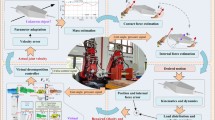Abstract
Recently, control approaches for a hydraulic robot in the field of robotics have attracted considerable attention owing to their high power-to-weight ratio. Many studies on behavior and control exploiting the advantages of hydraulic robots have been pursued. Application to hydraulically actuated systems, however, is not straightforward due to the nonlinear internal dynamics of the actuators. This paper presents a relatively simple method to improve the position precision of a hydraulic robot arm. We propose a simple control method concept based on a virtual spring–damper (VSD) controller, which enables the robot to realize a desired position. The main advantage of the VSD control is its simple calculation method, which eliminates the need to solve the Jacobian pseudo-inverse or ill-posed inverse kinematics. In this study, experiments were conducted to identify the problems in previous study results and evaluated the applicability of VSD control to the hydraulic robot arm. A relatively simple method was proposed to solve these problems and to verify improvements in the position precision. The proposed method is the dual VSD controller in which an additional VSD model is applied to the elbow, in addition to the conventional VSD model connected to the wrist. The effectiveness of the proposed control scheme is demonstrated in experimentation with the hydraulic robot arm.










Similar content being viewed by others
References
Vecna Robotics (2010) BEAR robot overview. https://www.youtube.com/watch?v=8rdRxV-qn3w. Accessed 15 Feb 2015
Raytheon-Sarcos (2011) Raytheon Sarcos modified ditch witch. https://www.youtube.com/watch?v=H9aeBIU-pvo&list=PLFBA2C80F6C49688D. Accessed 15 Feb 2015
Murphy MP, Stephens B, Abe Y, Rizzi AA (2012) High degree-of-freedom dynamic manipulation. In: Proceedings of SPIE 8387: 83870V-1–83870V-10
Merritt HE (1967) Hydraulic control systems. Wiley, London
Liyanage MH, Krouglicof N, Gosine R (2010) High speed electro-hydraulic actuator for a SCARA type robotic arm. In: Proceedings of the IEEE/RSJ international conference on intelligent robots and systems, pp 470–476
Liyanage MH, Krouglicof N, Gosine R (2011) Development and testing of a novel high speed SCARA type manipulator for robotic applications. In: Proceedings of IEEE international conference on robotics and automation, pp 3236–3242
Raibert M, Blankespoor K, Nelson G, Playter R (2008) BigDog, the rough-terrain quadruped robot. In: Proceedings of international federation of automatic control, pp 10822–10825
Boaventura T, Semini C, Buchli J, Frigerio M, Focchi M, Caldwell DG (2012) Dynamic torque control of a hydraulic quadruped Robot. In: Proceedings of IEEE international conference on robotics and automation, pp 1889–1894
Cho J, Park S, Kim K (2015) Design of mechanical stiffness switch for hydraulic quadruped robot legs inspired by equine distal forelimb. Electron Lett 51(1):33–35
Mettin U, La Hera PX, Morales O, Shiriaev AS, Freidovich LB, Westerberg S (2009) Trajectory planning and time-independent motion control for a kinematically redundant hydraulic manipulator. In: Proceedings of IEEE international conference on advanced robotics, pp 1–6
Hollerbach JM (1985) Optimum kinematic design for a seven degree of freedom manipulator. Robotics research: the second international symposium. MIT Press, Cambridge, pp 215–222
Siciliano B (1990) A closed-loop inverse kinematic scheme for on-line joint-based robot control. Robotica 8(3):231–243
Yang W, Chong NY, Kwon J You BJ, Self-sustaining rhythmic arm motions using neural oscillators. In: Proceedings IEEE/RSJ international conference on intelligent robots and system, pp 3585–3590
Yoshikawa T (1985) Manipulability of robotic mechanisms. Int J Robot Res 4(2):3–9
Kim Y, Song J (2011) Analytical inverse kinematics algorithm for a 7 DOF Anthropomorphic robot arm using intuitive elbow direction. J korea Robot Soc 6(1):27–33
Nakamura Y, Hanafusa H (1986) Inverse kinematic solutions with singularity robustness for robot manipulator control. J Dyn Syst Meas Control 108(3):163–171
Burdick JW (1989) On the inverse kinematics of redundant manipulators: characterization of the self-motion manifolds. In: Proceedings of the IEEE international conference on robotics and automation, pp 264–270
Sekimoto M, Arimoto S (2006) Experimental study on reaching movements of robot arms with redundant DOFs based upon virtual spring-damper hypothesis. In: Proceedings of IEEE international conference on intelligent robots and systems, pp 562–567
Arimoto S, Sekimoto M (2006) Human-like movements of robotic arms with redundant DOFs: virtual spring–damper hypothesis to tackle the bernstein problem. In: Proceedings of IEEE international conference on robotics and automation, pp 1860–1866
Bae J, Park J, Oh Y, Kim D, Choi Y, Yang W (2015) Task space control considering passive muscle stiffness for redundant robotic arms. Intell Serv Robot 8(2):93–104
Kim J, Cho J, Whang S, Chon S, Park S (2014) Method to apply virtual spring-damper hypothesis for a redundant hydraulic manipulator. In: International conference on ubiquitous robots and ambient intelligence, pp 454–457
Chon S, Cho J, Park S (2014) Experimental Study on Cartesian-space PD control for hydraulic manipulator. Int J Mater Mech Manuf 2(3):193–196
Acknowledgments
This work was supported by the Industrial Strategic technology development, 10047635, Development of Hydraulic Robot Control Technology based on Accurate and Fast Force Control for Complex Tasks funded By the Ministry of Trade, Industry and Energy (MI, Korea).
Author information
Authors and Affiliations
Corresponding author
Rights and permissions
About this article
Cite this article
Kim, J.T., Lee, J., Kim, H. et al. Method for improving the position precision of a hydraulic robot arm: dual virtual spring–damper controller. Intel Serv Robotics 9, 93–99 (2016). https://doi.org/10.1007/s11370-015-0182-1
Received:
Accepted:
Published:
Issue Date:
DOI: https://doi.org/10.1007/s11370-015-0182-1




